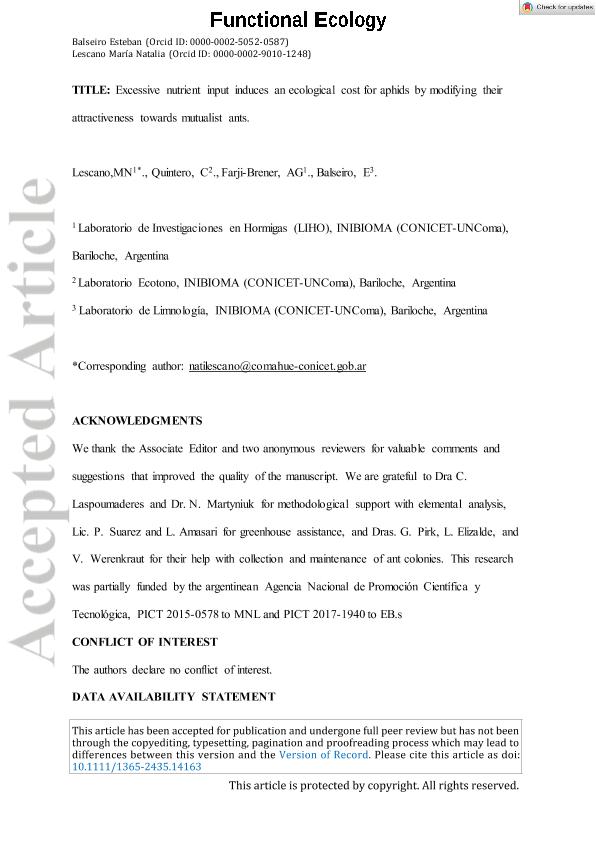Mostrar el registro sencillo del ítem
dc.contributor.author
Lescano, María Natalia

dc.contributor.author
Quintero, Carolina

dc.contributor.author
Farji Brener, Alejandro Gustavo

dc.contributor.author
Balseiro, Esteban Gabriel

dc.date.available
2023-07-04T14:54:22Z
dc.date.issued
2022-08
dc.identifier.citation
Lescano, María Natalia; Quintero, Carolina; Farji Brener, Alejandro Gustavo; Balseiro, Esteban Gabriel; Excessive nutrient input induces an ecological cost for aphids by modifying their attractiveness towards mutualist ants; Wiley Blackwell Publishing, Inc; Functional Ecology; 36; 10; 8-2022; 2661-2672
dc.identifier.issn
0269-8463
dc.identifier.uri
http://hdl.handle.net/11336/202276
dc.description.abstract
Enhanced soil nutrient availability often favours herbivore performance by bringing the carbon:nutrient ratio of plants closer to herbivore requirements. However, a surplus of nutrients can promote a too low carbon:nutrient ratio in plants, making them of poor quality for herbivores. In addition, increased soil nutrients can trigger cascading effects altering higher trophic levels, resulting in indirect costs for herbivores. Through experiments under three increasing fertilization levels (unfertilized, NPK-rich, and 2NPK-rich soils), we studied how the enhancement of soil nutrient availability, by modifying the C:N ratio of thistles, affects the performance and homeostatic response of the aphids, and the consequent ant attraction. Fertilized soils increased the biomass and reduced the C:N ratio of thistles, also increasing aphid abundance. The stoichiometric homeostasis of aphids was modulated through changes in honeydew production and composition; fertilization treatments reduced by more than half the quantity of honeydew secreted and lead to 2.5–6.4 times higher honeydew N concentration compared with the unfertilized treatment. In addition, in the highest fertilization treatment, the aphids increased the content of uric acid (a waste toxic compound involved in amino acid deamination) excreted in their honeydew. Aphid-infested thistles had the highest number of aphid-tending ants when they grew on intermediate rich-substrates. Ants selected honeydew with a lower C:N ratio (compared to unfertilized plants), but fewer workers patrolled plants with the highest fertilization treatment likely due to increased uric acid in the honeydew. We showed that enhanced soil nutrients brought plant C:N ratio closer to aphid requirements, enhancing their performance and promoting ant attendance. But a disproportionate increase in fertilization did not further improve aphid performance while it decreases the attraction of protective ants, which would make aphid populations more vulnerable to attack by natural enemies, inducing an ecological cost. This study highlights the complex role of bottom-up cascading effects triggered by increases in soil nutrient availability and the importance of evaluating not only the physiological and population cost and benefits of it but also the ecological ones; especially when it alters mutualistic interactions. Read the free Plain Language Summary for this article on the Journal blog.
dc.format
application/pdf
dc.language.iso
eng
dc.publisher
Wiley Blackwell Publishing, Inc

dc.rights
info:eu-repo/semantics/openAccess
dc.rights.uri
https://creativecommons.org/licenses/by-nc-sa/2.5/ar/
dc.subject
ANTS
dc.subject
APHIDS
dc.subject
BOTTOM-UP CASCADES
dc.subject
ECOLOGICAL STOICHIOMETRY
dc.subject
FERTILIZATION
dc.subject
KNIFE-EDGE HYPOTHESIS
dc.subject
TROPHIC INTERACTIONS
dc.subject.classification
Ecología

dc.subject.classification
Ciencias Biológicas

dc.subject.classification
CIENCIAS NATURALES Y EXACTAS

dc.title
Excessive nutrient input induces an ecological cost for aphids by modifying their attractiveness towards mutualist ants
dc.type
info:eu-repo/semantics/article
dc.type
info:ar-repo/semantics/artículo
dc.type
info:eu-repo/semantics/publishedVersion
dc.date.updated
2023-06-29T10:09:13Z
dc.journal.volume
36
dc.journal.number
10
dc.journal.pagination
2661-2672
dc.journal.pais
Reino Unido

dc.journal.ciudad
Londres
dc.description.fil
Fil: Lescano, María Natalia. Consejo Nacional de Investigaciones Científicas y Técnicas. Centro Científico Tecnológico Conicet - Patagonia Norte. Instituto de Investigaciones en Biodiversidad y Medioambiente. Universidad Nacional del Comahue. Centro Regional Universidad Bariloche. Instituto de Investigaciones en Biodiversidad y Medioambiente; Argentina
dc.description.fil
Fil: Quintero, Carolina. Consejo Nacional de Investigaciones Científicas y Técnicas. Centro Científico Tecnológico Conicet - Patagonia Norte. Instituto de Investigaciones en Biodiversidad y Medioambiente. Universidad Nacional del Comahue. Centro Regional Universidad Bariloche. Instituto de Investigaciones en Biodiversidad y Medioambiente; Argentina
dc.description.fil
Fil: Farji Brener, Alejandro Gustavo. Consejo Nacional de Investigaciones Científicas y Técnicas. Centro Científico Tecnológico Conicet - Patagonia Norte. Instituto de Investigaciones en Biodiversidad y Medioambiente. Universidad Nacional del Comahue. Centro Regional Universidad Bariloche. Instituto de Investigaciones en Biodiversidad y Medioambiente; Argentina
dc.description.fil
Fil: Balseiro, Esteban Gabriel. Consejo Nacional de Investigaciones Científicas y Técnicas. Centro Científico Tecnológico Conicet - Patagonia Norte. Instituto de Investigaciones en Biodiversidad y Medioambiente. Universidad Nacional del Comahue. Centro Regional Universidad Bariloche. Instituto de Investigaciones en Biodiversidad y Medioambiente; Argentina
dc.journal.title
Functional Ecology

dc.relation.alternativeid
info:eu-repo/semantics/altIdentifier/url/https://onlinelibrary.wiley.com/doi/10.1111/1365-2435.14163
dc.relation.alternativeid
info:eu-repo/semantics/altIdentifier/doi/http://dx.doi.org/10.1111/1365-2435.14163
Archivos asociados
